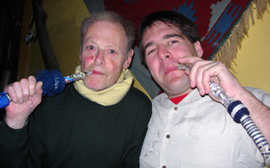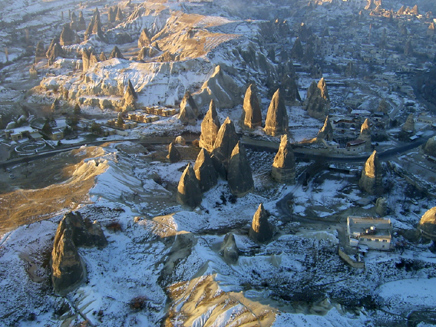
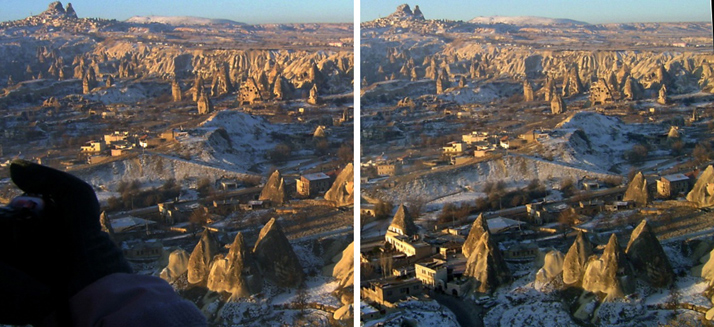

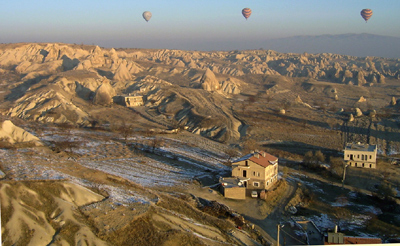
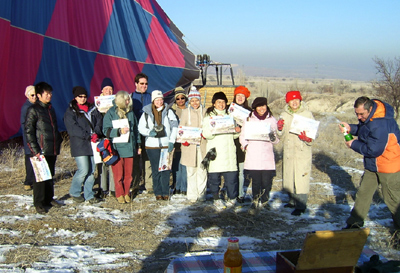
I booked on to EXPLORE tour TU22DEC07, Asia Minor Explorer, thinking of finding warmth during an English winter. I wanted to visit the land of my Turkish friends at Birmingham University, become immersed in Islamic culture in the great mosques of Istanbul, buy a Turkish carpet, and go hot-air ballooning over the volcanic landscape of Cappadocia. Western Anatolia isn't warm at Christmas time, but the others on our tour were warm, and Ceylan Tuna was warm and caring, an excellent tour guide. The flight from Heathrow to Istanbul was noteworthy for stagnant weather conditions: aircraft left black condensation trails and there was an opaque layer of smog at altitude 10-11 km. Later we found much winter air pollution over Turkey, apparently a chronic problem.
With two nights in Istanbul, I took stereo-pair photos of the Blue Mosque. A huge and wonderful celebration of Islam, it overwhelms the senses and defies comprehension. The Topkapi Palace is nearby, and it has a cafe overlooking the Bosphorus - a fine place for a meal, enjoyed with the mild-mannered civil servant Angela Martin. I went in search of a Turkish carpet, causing dismay when I said that I would come back later to buy when I had seen a little more of Turkey. I took a (very) expensive taxi ride to the Süleymaniye Mosque.
In Istanbul I shared a room with Thomas Hanson. I don't sleep many hours at a time and get up during the night. Would this bother Thomas? No. But actually it did. On the second night Thomas accidentally made a loud cracking noise with a plastic water bottle, which I thought was deliberate, so when I next got up to rearrange belongings I didn't bother about being quiet. Thomas complained to Ceylan that I was "not normal". Next day at the Anatolian Civilizations Museum Ceylan was showing me Ottoman severity, and Thomas was emphasising that the Loughborough rugby team was a background to be respected and that there had better be no nonsense about the England national team. On the long drive to Ankara, I became anxious when Ceylan didn't help me contact my friend Altunkan Hizal of the Middle East Technical University, whom I hadn't seen for 30 years. It seemed that the smog that we had seen on the flight out might have been suitable for the sort of study that Hizal and I did. I needed help because I'd lost Hizal's contact details. When we got to Ankara and the memorial to Kemal Ataturk I set off by myself to find our hotel and contact Hizal, and we enjoyed a successful reunion. I had to make peace with the rest of the group for getting lost - with help from Keith Boot and David Betts, practical and helpful people.
From Ankara we drove on Christmas Day to the Museum of Anatolian Civilizations. At Hacibektaş we enjoyed more Islamic decorative art. In the disturbed landscape of Cappadocia we settled in to our hotel in Ürgüp. For Thomas' sake, I put in 8 hours of noiseless rest, before we went hot air ballooning at 0730 next morning. The temperature was -8°C. Constrained to stand still in the basket, I was weak and numb, and grateful to Thomas who managed to fix my camera. Drifting in the light easterly airs of early morning, we negotiated power lines and used ground crew to land, led in impressive style by Cihangir Cihangiroglu, shown below at right breaking out celebratory champagne:





A hike through the Rose Valley followed, into Christian churches cut into the volcanic tuff, notably at the Göreme Museum. In the evening I bought my carpet in Ürgüp; it was from the Iranian region of Ararat rather than Turkey, and had been given a golden wash to make it look old - at £250 a pleasing though not an ideal purchase. (Had I paid less than £250 I would have escaped paying £44 at Customs on return home.)
Across the frozen wastes we saw a small caravanserai trading post on the way to Konya, centre of civilizations of the 12th and 13th centuries. We stayed overnight at the lakeside resort of Egirdir and proceeded south to the Mediterranean coast by Antalya. We walked up to the flame on Mount Olympos and settled down in Kaş. This delightful town offers canoe trips over submerged ruins at Kekova, and photogenic box tombs at the isolated village at Simena.
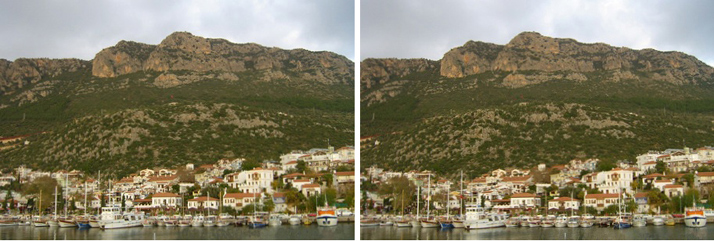

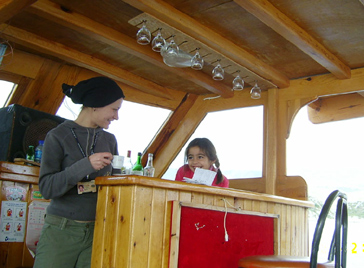
We went from Kaş to Dalyan for a night and then inland to the classical sites at Hierapolis and Pamukkale, where there was a fine New Year's Eve party with dancing and a lot of noise. Next day we visited Aphrodisias.
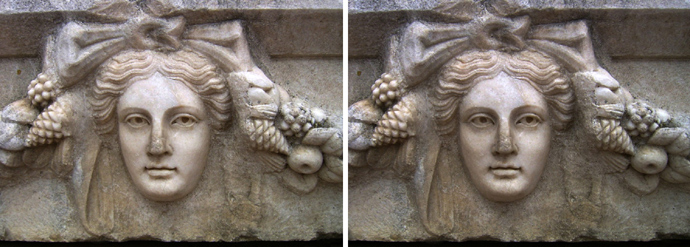
We drove on to the Hitit Hotel near Selçuk. Ephesus was a crossing point between west and east ~2000 BCE and was Ionian from the 11th century BCE. The Temple of Artemis, Greek goddess of the hunt, was one of the seven wonders of the ancient world. It was burnt down in 356 BCE, on the night of the birth of Alexander (later the Great). Lysimachos, a successor of Alexander, conquered the city in 283 BCE and rebuilt it at the foot of Ayasaluk hill, after the original site became swampy and unhealthy.
Ephesus was brought under the rule of Egypt and Syria. Then it was mastered by the Romans in 190 BCE. The Turks captured Ephesus in the early years of the 11th century, and Byzantine influence declined through to the 14th century, when the city was conquered by Isa Bey. The Ottomans came in 1390, and Smyrna (now Izmir) rose in importance. Ayasaluk was called Selçuk from 1914.

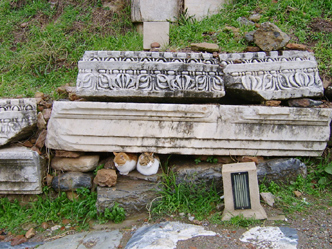
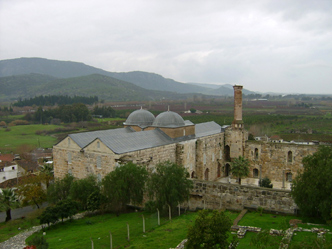
We proceeded to Pergamon and Troy and Çannakale, resort for the battlefields of Gallipoli. The novel Birds Without Wings by Louis de Berniere gives a vivid account of this campaign of 1915-6, of rural life, and of the rise of Mustapha Kemal (Ataturk), culminating in the establishment of modern Turkey in 1923.
